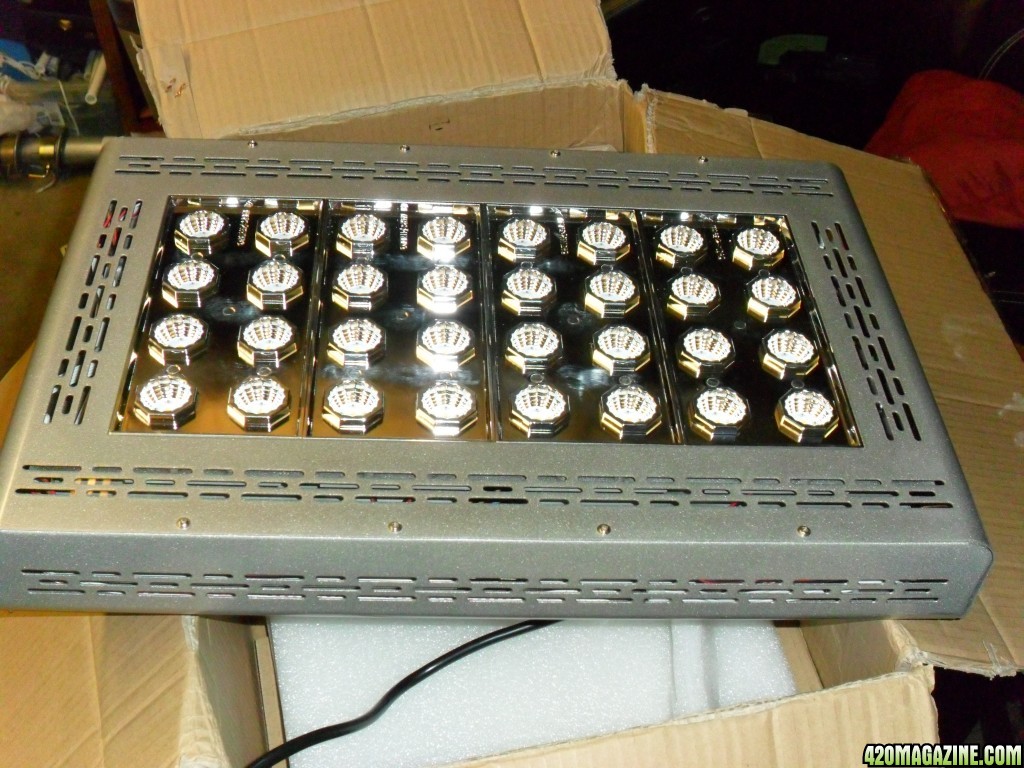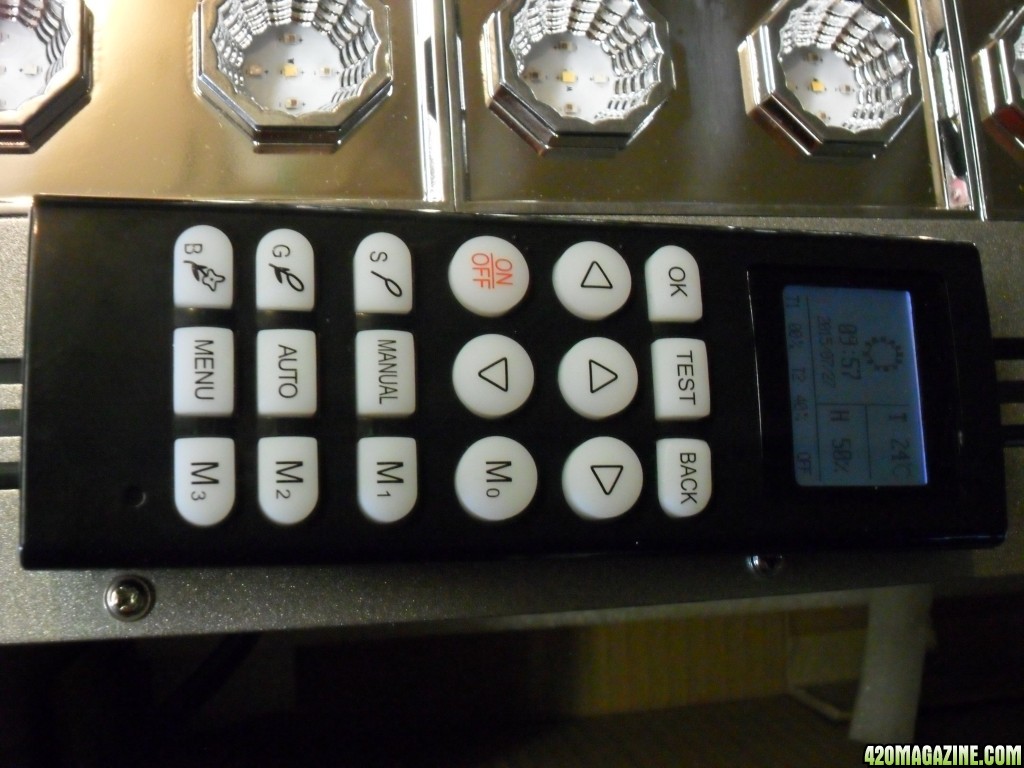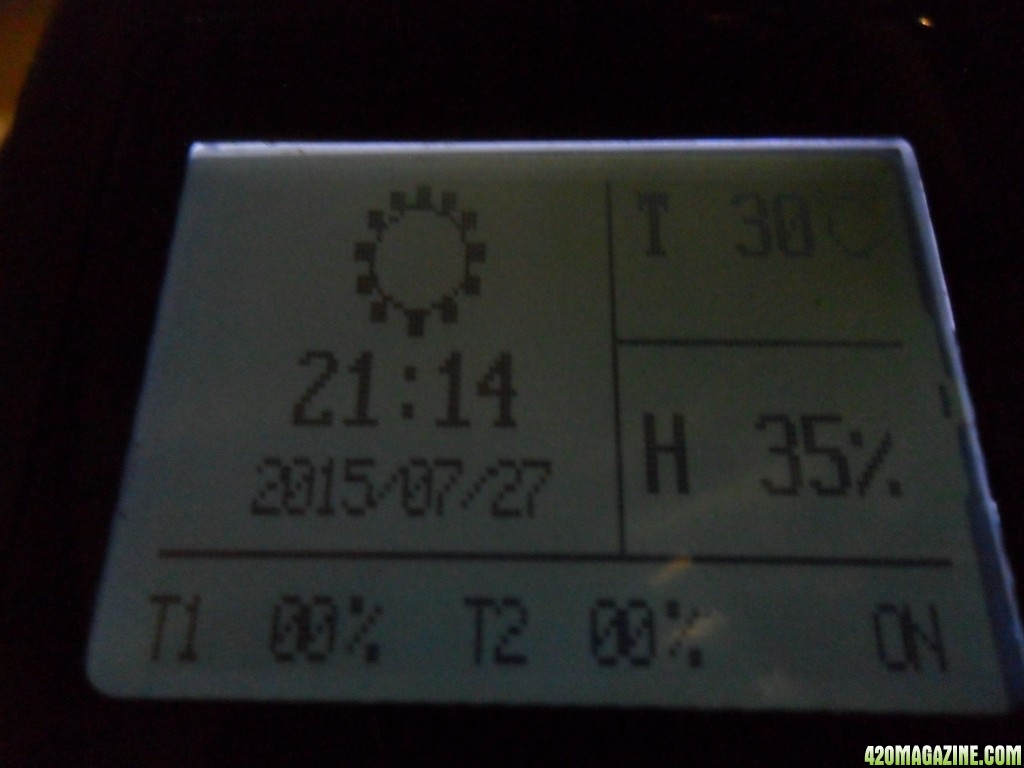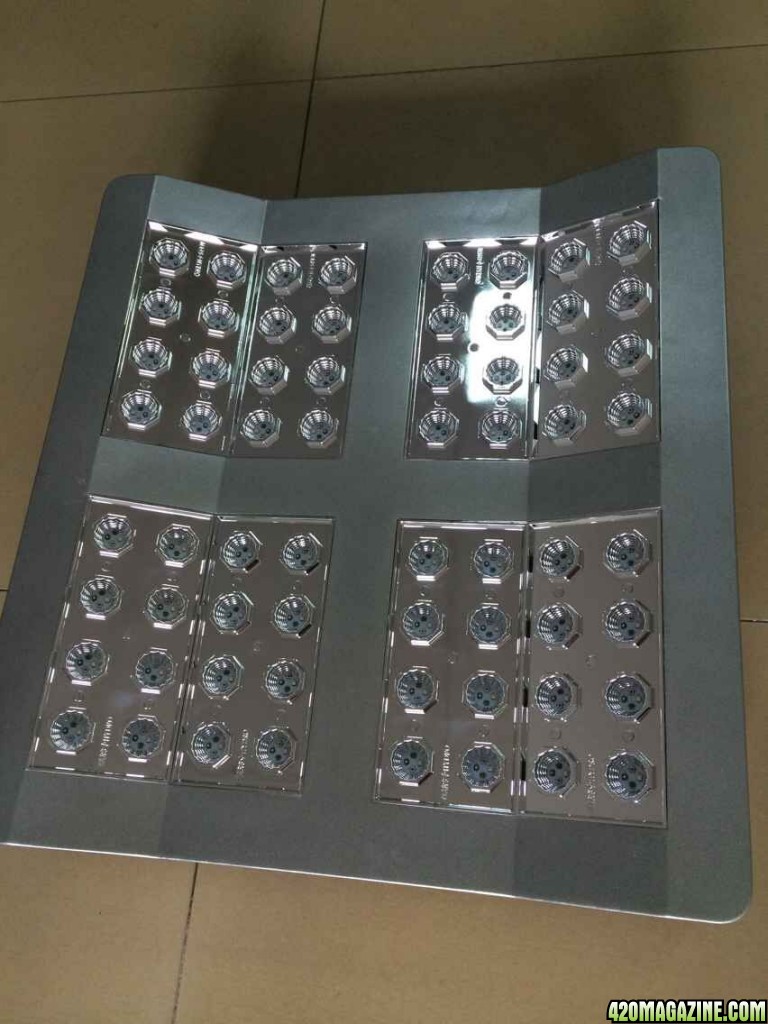- Thread starter
- #15,381
Mars Hydro
420 Sponsor
 18~20" is a little high during flower stage.
18~20" is a little high during flower stage.I wanted to ask the same question. how high were those lights above canopy?
okay I got the answer 18-20 inches.
How To Use Progressive Web App aka PWA On 420 Magazine Forum
Note: This feature may not be available in some browsers.
 18~20" is a little high during flower stage.
18~20" is a little high during flower stage.I wanted to ask the same question. how high were those lights above canopy?
okay I got the answer 18-20 inches.
welcome Zebs and thanks for join us. I prefer MarsII to the Old Model. The coverage of MarsII 400w is 0.9x0.9m at the height of 0.6m. For 1mx1m, MarsII900w will be a better choice. MarsII 900w will cover 1.2mx1.2m at the height of 0.6m. During flower, you can still cover the area well.
MarsII 1200w will draw more power than MarsII 900w.
4pcs smaller lights will give you better light distribution.
Putting any more panels in my tent is obviosly a ridiculous suggestion,
Well with all the Epistar led talk I have seen here I thought this would be a good time to show you all a look at the new Mars Hydro light that is going to have a option for CREE or Epistar led in it.
Here is the Epistar



And here is the CREE

Mars Hydro is going big... Keep it growing green..
HAHAHA this is not ridiculous at all
you are using 1100W for 25 sqft .... this is 44w/ sqft and this is the minimum to have good light power. you dont want good light power .... you want FULL LIGHT POWER. you better have around 1300-1400 total true watts and even more and put the light at the right distance over the cannopy (12 inchs). 6 inchs more high and you have clearly less power. 1100W instead of 1400W and you have clearly less power again.
you may think it is ridiculous if you want ..... maybe one of theses day you will understand to add more light power to acheive big goals as you want.
a lot of respected growers are using the same watt / sqft as HPS for medium quality led panels as marshydro ... personnaly i am not using as much power, but they are certainly not ridiculous
will not help you anymore anyway ... good luck

HAHAHA this is not ridiculous at all
you are using 1100W for 25 sqft .... this is 44w/ sqft and this is the minimum to have good light power. you dont want good light power .... you want FULL LIGHT POWER. you better have around 1300-1400 total true watts and even more and put the light at the right distance over the cannopy (12 inchs). 6 inchs more high and you have clearly less power. 1100W instead of 1400W and you have clearly less power again.
you may think it is ridiculous if you want ..... maybe one of theses day you will understand to add more light power to acheive big goals as you want.
a lot of respected growers are using the same watt / sqft as HPS for medium quality led panels as marshydro ... personnaly i am not using as much power, but they are certainly not ridiculous
will not help you anymore anyway ... good luck

Watts is a moot point when choosing LED lighting, the ONLY unit of measurement to correctly pick LED lighting is by PPFD. You could have 2 lights, both 100 watts, one with a 30 degree beam angle and the other with 120 degree beam angle...both with the same wattage but the coverage would be different, light distribution could be different, and wattage means nothing when translated to a plants needs.
Another example, lets say you have a 500w LED at 12" or a 500w LED at 48"... well by your description of judging plant lighting, how would wattage tell proper hanging height of the light?? It doesn't.
Plants are photon counters and it takes approx 8 photons to convert 1 molecule of CO2, therefore the only reasonable measurement to judge plant lighting is by using PPFD (PAR readings as many know it by). The correct way is to measure the PPFD across a 4x4 grid, with a quantum meter/par meter/spectroradiometer. As someone posted a few days ago, Cannabis needs a minumum DLI of 22 Mol/day/m2 andd can go as high as 65 mol/day/m2 which translates in a 12/12 schedule to a minimum of 510 umol/m2/s-1 and tops out around 1500 umol/m2/s-1. (anything over 1000 umol/m2/s-1 should also be complimented with additional atmospheric CO2.).
I understand a lot of people get confused by all the terms and misinformation on the internet, but this is the only way that plant lighting should be measured, by DLI or PPFD.
Judging plant lighting by wattage to find coverage area is like measuring water with a fork.
 Haha just kidding, I think soon enough there will be a set standard that we all understand and can use, and that will happen because of people that do care and share. +reps for the post
Haha just kidding, I think soon enough there will be a set standard that we all understand and can use, and that will happen because of people that do care and share. +reps for the post 
In commercial greenhouses, several strategies can be used to help properly manage light levels
throughout the day and seasonally. Some of the primary reasons why greenhouses manipulate light levels include temperature and irrigation management, photoperiod control, minimizing crop stress, and optimizing photosynthesis.
Supplemental lighting with high-intensity discharge (HID) lamps can increase the light intensity a crop receives and improve and accelerate its growth and development. Retractable shade curtains and whitewash can reduce and scatter light intensity to create a more desirable growing environment during high-light periods. This publication examines the characteristics of green-house lighting and describes one management option, daily light integral (DLI).
What Is Light and Why Is It Important?
Light is a form of energy called electromagnetic radiation. Electromagnetic radiation, whether from sunlight or HID lamps [e.g., high-pressure sodium lamps (HPS) or metal halide] varies in duration (energy over time), quality (wavelength or color), and intensity (the amount of light at each wavelength or color).
We will only focus on photosynthetically active radiation (PAR), which is light with a wavelength between 400 to 700 nm – this also happens to be the light people can perceive. Increasing energy in the PAR range increases plant photosynthesis, (the plant's most basic metabolic process). Each crop species has an optimal light intensity that maximizes photosynthesis and plant growth. When there is not enough light, growth and crop quality can decline; and if there is excessive light, photosynthesis and growth will not increase despite the expense of keeping the lights on.
Measuring Light
The most common units for measuring light are the foot-candle (primarily in the United States) and lux (primarily in Europe). It is important for growers to understand the limitations of these units. Both units provide an instantaneous light intensity at the time the reading is taken. As we all know, natural light levels are continuously changing and a single measurement in time does not
accurately represent the amount of light a plant has received in a day. Just as important, foot-candles are "photometric" units based on the amount of visible light detected by the human eye (primarily green light). That means foot-candles are focused on people
and not appropriate for indicating plant photosynthesis.
Most horticultural researchers measure instantaneous light in micromoles (μmol) per square meter (m2) per second (s-1), or: μmol·m-2
·s-1 of PAR. This "quantum" unit quantifies the number of photons (individual particles of energy) used in photosynthesis that fall on a square meter (10.8 square feet) every second. However, this light measurement also is an instantaneous reading.
Daily Light Integral
Daily light integral (DLI) is the amount of PAR received each day as a function of light intensity (instantaneous light: μmol·m-2·s-1) and duration (day). It is expressed as moles of light (mol) per square meter (m-2) per day (d-1), or: mol·m2·d-1 (moles per day).
The DLI concept is like a rain gauge. Just as a rain gauge collects the total rain in a particular location over a period of time, so DLI measures the total amount of PAR received in a day. Greenhouse growers can use light meters to measure the number of light photons
that accumulate in a square meter over a 24-hour period. Jim Faust and colleagues at Clemson University have developed maps of monthly outdoor DLI throughout the United States (Figure 1). These maps illustrate how latitude, time of year, length of day (photoperiod), and cloud cover influence DLI and vary from 5 to 60 mol∙m-2∙d-1. In a greenhouse, values seldom exceed 25 mol∙m-2∙d-1
because of greenhouse glazing materials and superstructure, the season (which affects the sun's angle), cloud cover, day length photoperiod), shading, and other greenhouse obstructions, such as hanging baskets.
The Importance of DLI in Greenhouse Production
DLI is an important variable to measure in every greenhouse because it influences plant growth, development, yield, and quality. For example, DLI can influence the root and shoot growth of seedlings and cuttings, finish plant quality (characteristics such as
branching, flower number and stem thickness), and timing. Commercial growers who routinely monitor and record the DLI received by their crops can easily determine when they need supplemental lighting or retractable shade curtains. This is especially true for growers in northern latitudes where the majority of crops are propagated from December to March and naturally occurring outdoor DLI values are between 5 to 30 mol·m-2·d-1. Furthermore, these values can be 40 to 70 percent lower because of shading from greenhouse glazing,
structures, and hanging baskets. These obstructions can result in an average DLI as low as 1 to 5 mol·m-2·d-1. There are devices that automatically measure and calculate the DLI your greenhouse crops are receiving. One of these is the WatchDog weather station
manufactured by Spectrum Technologies (Figure 2). This instrument is portable and should be placed next to your crop to determine the DLI for that particular area. Some models can be connected to download data automatically to a computer.
Measuring Daily Light Integral in a Greenhouse
Another method to measure DLI is to use a light quantum sensor connected to a data logger or computer (Figure 3). The sensor measures instantaneous light intensity (preferably in μmol.m-2.s-1) at some defined interval (such as once every 15 to 60 seconds),
which allows you to calculate DLI. Table 1 on page 4 provides DLI calculations based on average hourly foot-candles or μmol·m-2·s-1 of PAR measurements. No matter which sensors you use, it is important to keep all light sensors level and clean to assure accurate readings.
DLI Recommendations
Plants grown under light-limiting conditions (a low DLI), typically have delayed growth and development. Research conducted at Michigan State University indicated that maintaining a DLI between 4 to 11 mol·m-2·d-1 during stage 2 (callusing) and stage 3
(root development) accelerates propagation of petunia and New Guinea impatiens cuttings (Figure 4). Experiments with these petunias and New Guinea impatiens have shown that, as propagation DLI increases, rooting, biomass accumulation (root and shoot growth), and quality (reduced stem elongation) generally increase, while subsequent time to flower generally decreases. Similarly, experiments with
seedlings of celosia, impatiens, salvia, marigold, and viola showed that quality parameters at transplant increased when DLI increased up to 12 mol·m-2·d-1. Based on this research, we recommend that greenhouse growers provide a minimum of 10 to 12 mol·m-2·d-1 of light during the finish stage to produce many shade-intolerant floriculture crops. But remember, DLI requirements differ between greenhouse crops as outlined in Table 2 on pages 5-7. Some growers separate their floriculture crops by DLI requirements. Crops with a DLI requirement of 3 to 6 mol·m-2·d-1 are considered low-light crops, 6 to 12 mol·m-2·d-1 are medium-light crops, 12 to 18 mol·m-2·d-1
are high-light crops, and those requiring more than 18 mol·m-2·d-1 are considered very high-light crops.
